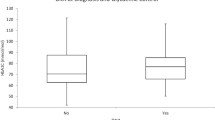Abstract
To evaluate the association between recreational drug use and diabetic ketosis (DK) and diabetic ketoacidosis (DKA) in our area. Retrospective examination of records from a 1,450 bed urban teaching hospital in Spain. All adult admissions for DK or DKA from January 1, 2005, to December 31, 2009 in our hospital were included. Demographic, exploratory (blood pressure, heart rate, respiratory rate), and analytical data (glucose, urea, creatinine, corrected Na+, K+, pH, HCO3− and HbA1c) at admittance were recorded. In 152 patients, 253 episodes of DK or DKA occurred. Screening for drug use was performed in 40.3% of the events; 20.6% of the episodes (n = 52) were shown to be substance abuse. Cocaine, followed by cannabis and alcohol, was the most frequently involved drug. Poly-substance abuse occurred in 67.3% of them. Comorbidities were present in 11.5 and 39.8% of the cases shown and not shown to be related to drug use (P = 0.00). Seventy percent of the patients who were at least once shown to have consumed drugs, and 15.9% of those who were never shown to have done so, were admitted more than once (P = 0.00). The frequency of recent drug misuse in patients presenting with DK or DKA was high. Substance abuse screening was frequently neglected. Adverse profile, most significantly in readmission to hospital, was found in the patients with positive drug findings. History taking in this context should routinely include questions on substance abuse, and toxicology screening may be worthwhile, particularly in those with the history of frequent readmissions.
Similar content being viewed by others
References
Ng RSH, Darko DA, Hillson RM (2003) Street drug use among young patients with type 1 diabetes in the UK. Diab Med 21:295–296
Gold MA, Gladstein J (1993) Substance use among adolescents with diabetes mellitus: preliminary findings. J Adolesc Health 14:80–84
Frey MA, Guthrie B, Loveland-Cherry C, Park PS, Foster CM (1997) Risky behavior and risk in adolescents with IDDM. J Adolesc Health 20:38–45
Glasgow AM, Tynan D, Schwartz R et al (1991) Alcohol and drug use in teenagers with diabetes mellitus. J Adolesc Health 12:11–14
Martínez-Aguayo A, Araneda JC, Fernández D, Gleisner A, Pérez V, Codner E (2007) Tobacco, alcohol, and illicit drug use in adolescents with diabetes mellitus. Pediatr Diabetes 8:265–271
Polonsky WH, Anderson BJ, Lohrer PA, Aponte JE, Jacobson AM, Cole CF (1994) Insulin omission in women with IDDM. Diabetes Care 17:1178–1185
Peyrot M, Rubin RR, Kruger DF, Travis LB (2010) Correlates of insulin injection omission. Diabetes Care 33:240–245
Cramer JA, Pugh MJ (2005) The influence of insulin use on glycemic control: how well do adults follow prescriptions for insulin? Diabetes Care 28:78–83
Morris AD, Boyle DI, McMahon AD, Greene SA, MacDonald TM, Newton RW (1997) Adherence to insulin treatment, glycaemic control, and ketoacidosis in insulin-dependent diabetes mellitus. The DARTS/MEMO collaboration. Diabetes audit and research in tayside Scotland. Medicines monitoring unit. Lancet 350:1505–1510
Musey VC, Lee JK, Crawford R, Klatka MA, McAdams D, Phillips LS (1995) Diabetes in urban African-Americans. I. Cessation of insulin therapy is the major precipitating cause of diabetic ketoacidosis. Diabetes Care 18:483–489
Affenito SG, Backstrand JR, Welch GW, Lammi-Keefe CJ, Rodriguez NR, Adams CH (1997) Subclinical and clinical eating disorders in IDDM negatively affect metabolic control. Diabetes Care 20:182–184
Jones JM, Lawson ML, Daneman D, Olmsted MP, Rodin G (2000) Eating disorders in adolescent females with and without type 1 diabetes: cross sectional study. BMJ 320:1563–1566
Katon W, von Korff M, Ciechanowski P et al (2004) Behavioral and clinical factors associated with depression among individuals with diabetes. Diabetes Care 27:914–920
Peveler RC, Bryden KS, Neil HA, Fairburn CG et al (2005) The relationship of disordered eating habits and attitudes to clinical outcomes in young adult females with type 1 diabetes. Diabetes Care 28:84–88
McNally K, Rohan J, Pendley JS, Delamater A, Drotar D (2010) Executive functioning, treatment adherence, and glycemic control in children with type 1 diabetes. Diabetes Care 33:1159–1162
Laing SP, Swerdlow AJ, Slater SD et al (1999) The British diabetic association cohort study, II: cause-specific mortality in patients with insulin-treated diabetes mellitus. Diabet Med 16:466–471
Umpierrez GE, Kelly JP, Navarrete JE, Casals MM, Kitabchi AE (1997) Hyperglycemic crises in urban blacks. Arch Intern Med 157:669–675
Warner EA, Greene GS, Buchsbaum MS, Cooper DS, Robinson BE (1998) Diabetic ketoacidosis associated with cocaine use. Arch Intern Med 158:1799–1802
Nyenwe EA, Loganathan RS, Blum S et al (2007) Active use of cocaine: an independent risk factor for recurrent diabetic ketoacidosis in a city hospital. Endocr Pract 13:22–29
Saunders SA, Democratis J, Martin J, Macfarlane IA (2004) Intravenous drug abuse and type 1 diabetes: financial and healthcare implications. Diabet Med 21:1269–1273
Laing SP, Jones ME, Swerdlow AJ, Burden AC, Gatling W (2005) Psychosocial and socioeconomic risk factors for premature death in young people with type 1 diabetes. Diabetes Care 28:1618–1623
Ministerio de Sanidad y Consumo (2006) Campañas 2006—prevención del consumo y adicción a cannabis y cocaína. Available from http://www.msps.es/campannas/campanas06/drogas2.htm. Accessed 28 May 2010
Lee P, Greenfield JR, Campbell LV (2009) Managing young people with type 1 diabetes in a ‘rave’ new world: metabolic complications of substance abuse in type 1 diabetes. Diabet Med 26:328–333
Lee P, Greenfield JR, Campbell LV (2008) “Mind the gap” when managing ketoacidosis in type 1 diabetes. Diabetes Care 31:e58
Author information
Authors and Affiliations
Corresponding author
Rights and permissions
About this article
Cite this article
Isidro, M.L., Jorge, S. Recreational drug abuse in patients hospitalized for diabetic ketosis or diabetic ketoacidosis. Acta Diabetol 50, 183–187 (2013). https://doi.org/10.1007/s00592-010-0243-z
Received:
Accepted:
Published:
Issue Date:
DOI: https://doi.org/10.1007/s00592-010-0243-z




